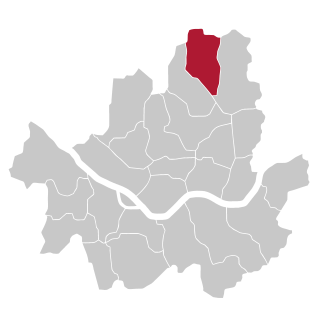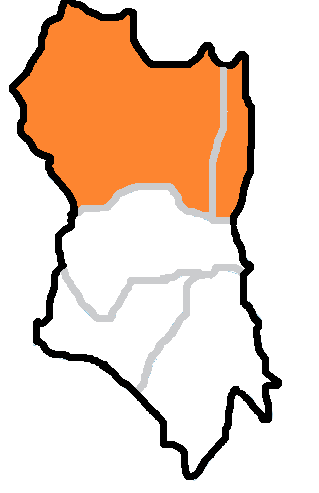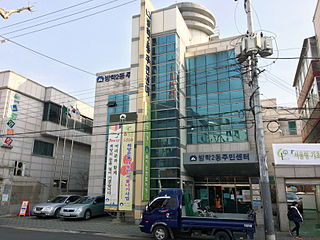
Dobong District is one of the 25 districts of Seoul, South Korea. As of 2020, Dobong has a population of 315,979 and an area of 20.71 square kilometres (8.00 sq mi), and is divided into four administrative neighborhoods. The district is located in northeastern Seoul, bordering the Gyeonggi Province cities of Yangju and Uijeongbu to the north, and the districts of Gangbuk to the southwest and Nowon to the east.

Chang-dong Station is a station on Seoul Subway Line 1 and Line 4. It is located in Chang-dong, Dobong-gu, Seoul. A shopping center was planned for this site, but the empty lot has never been developed due to the bankruptcy of the contractor behind said project. The station is, however, home to a cluster of pojangmacha stalls.

Dogok-dong is an affluent ward of Gangnam-gu in Seoul, South Korea. It is home to high-end residential homes including the Samsung Tower Palace, a luxury residential complex which contains the eleventh-tallest building in South Korea.

Dobong-dong is a dong, a neighbourhood of Dobong-gu in Seoul, South Korea. The dong is one of the four located in the Dobong District. According to the Köppen–Geiger climate classification system, the region is Dwa, or a humid continental climate. The average temperature is 11.1°C and approximately 147.5 cm of precipitation falls annually. The postal code for Dobong-dong is 132-010. The region is also referred to as Tobong-dong.

Banghak-dong is a dong, neighbourhood of Dobong-gu in Seoul, South Korea.

Ssangmun-dong is a dong, neighbourhood of Dobong District in Seoul, South Korea.

Amsa-dong is a dong (neighbourhood) of Gangdong-gu in Seoul, South Korea. The dong is well known for the Amsa-dong Prehistoric Settlement Site, in which Neolithic remains were excavated after a large amount of diagonal-line patterned earthenware was exposed by a flood in 1925.
Siheung-dong is a dong, neighbourhood of Geumcheon-gu in Seoul, South Korea.
Hyoja-dong is a dong, neighbourhood of Jongno-gu in Seoul, South Korea.
Changseong-dong is a dong, neighbourhood of Jongno-gu in Seoul, South Korea. It is a legal dong administered under its administrative dong, Hyoja-dong.

Ihwa-dong is a dong, neighbourhood of Jongno-gu in Seoul, South Korea.

Hyehwa-dong is a dong (neighborhood) of Jongno-gu in Seoul, South Korea. It is adjacent to the Seoul National University Hospital.

Anguk-dong is a dong, neighbourhood of Jongno-gu in Seoul, South Korea. It is a legal dong administered under its administrative dong, Samcheong-dong.
Pyeong-dong is a dong, neighbourhood of Jongno-gu in Seoul, South Korea. It is a legal dong administered under its administrative dong, Gyonam-dong.

Anam-dong is a dong, neighbourhood of Seongbuk-gu in Seoul, South Korea.
Bangsan-dong is a legal dong, or neighbourhood of the Jung-gu district in Seoul, South Korea and governed by its administrative dong, Euljiro 3, 4, 5ga-dong.
Cho-dong is a legal dong, or neighbourhood of the Jung-gu district in Seoul, South Korea and governed by its administrative dong, Euljiro 3, 4, 5-dong.
Mugyo-dong is a legal dong, or neighbourhood of the Jung-gu district in Seoul, South Korea and governed by its administrative dong, Myeong-dong.
Changcheon-dong is a dong, neighbourhood of Seodaemun-gu in Seoul, South Korea. The sole Mormon Temple in South Korea is located here.
Gusu-dong is a dong, neighbourhood of the Mapo-gu district in Seoul, South Korea.











